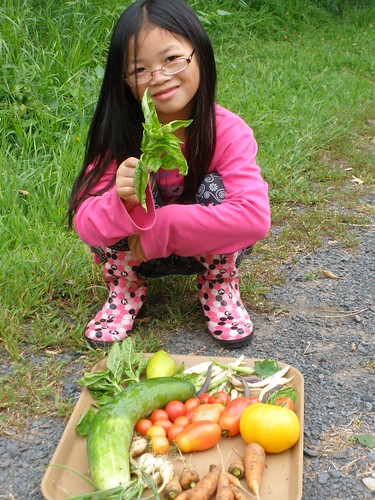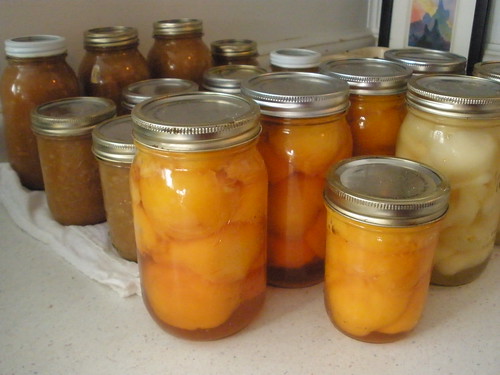As a mother who homeschools her two daughters, I particularly appreciated this interesting article by Shannon Hayes about one homeschool family's quest to eat locally and an educational trip they took where the children eagerly ate snails. As Shannon said, "Each year at this time, we pack up the kids for a journey that is one part celebration of the close of the growing season, one part homeschool study."
This article, 8 Ways to Join the Local Food Movement, by Sarah van Gelder offers some great ideas. Some of them I've already done, and others I'm definitely going to try this spring and summer when the growing season begins again. (Right now the ground is covered with a good foot of snow.)
From Lawn to Lunch
One idea offered in the article was to "convert your sunny lawn to a lunch box by removing the turf in long, 18-inch strips. Cut the edges of each strip with a sharp-bladed edging tool. While one partner rolls up the grass like a jellyroll, another slices through grass roots with the edging tool. Remove about an inch of rooty soil with the top growth. When the roll gets heavy, slice it off and load it in a wheelbarrow.
"Make beds 10 to 20 feet long and six to eight feet wide (so you can reach the center from each side). Mulch three to four-foot wide paths between beds (grass left in the path will infiltrate your beds) to accommodate a wheelbarrow." The turf can be added to the compost pile. From there, prepare the garden beds for planting. Further instructions are at the link above.
This is such a great idea! The garden would be easily accessible from both sides and make weeding and harvesting so much easier.
Olivia holding some basil -
one of the many things harvested one night from the garden.
There are many sunny spots in the backyard, and this spring it would be good to add another spot where we can plant more vegetables.
In the meantime, I'm thinking about the delicious salads and cornbread that I enjoyed for many lunches. The majority of the ingredients for the salads came right out of the garden:
One of the many lunches I enjoyed during Summer 2010
using fresh produce the girls and I grew in the garden.
This is something I've never done, but love the idea (it's from the article noted above):
Party with Your Preserves
Ten quarts of pumpkin puree in the pantry, and not a jar of tomato sauce left? Throw a canning swap party. Here are some tips and recommendations from foodroutes.org:
Plan ahead.
Gauge interest with your friends early on. Then remind them throughout the planting, growing, and harvesting season to set aside extras for canning and swapping.
Don’t be afraid to grow a lot of something.
If you’re a budding salsa artist, plant that extra row of tomatoes. Or if you see a good deal on a box of local pears—get them.
Try new recipes on your swappers.
Canned applesauce, peaches, and pears.
Be aware of what constitutes a “fair” trade.
This is simple. You’re all friends and canners who know how time-consuming canning can be. Be open and ask what your neighbor feels comfortable receiving in exchange for one jar of Grandma Edie’s apricot chutney.
Think outside the Ball Jar.
Not everything at the canning swap party has to be pressure-canned or boiled in a hot water bath. Dried items, homemade baked goods, and candies are all eligible. You’ll be amazed by what can be preserved from the season’s bounty.
Shop Outside of Supermarkets
The article suggested that you could "ask around at farmers markets, look for road-side food stands, and U-pick places. Watch for hand-painted signs. You may find a wide variety of freshly harvested foods and get to know new communities and regional traditions at the same time."
One of my favorite memories of the past summer was visiting Amish farms in Cashton, Wisconsin. My parents and daughters went to many different farms, and purchased fresh produce - much of it well under the price in the grocery store.
Following an Amish buggy on the way to different farms in the Cashton area.
One of the CSA farms also had a gleaning program where we could pick all the tomatoes we wanted that were not being used so they wouldn't go to waste. This was wonderful - and a huge source of savings. I ended up canning and drying a considerable amount of tomatoes.
This website helps locate CSAs across the United States. I was happy to find 43 listings near me for a variety of CSA farms as well as ones that offer organic or natural products - some even year round!
Share Your Table
The article also suggested that "the best antidote to fast-food culture is as close as your table. Invite friends and a few strangers to a local-foods potluck. In good weather, eat outside. Share an evening of conversation and enjoy the good life."
There was also an interesting article about a man who lives in Paris and invites people over every Sunday evening. A changing group of about 50-60 people from around the world have joined him over the past 40 years. Here's the article.
One of the steps suggested today is to eat locally. In January in Minnesota, there's not a lot growing naturally. Out of curiousity, I wanted to see the NRDC's (National Resoures Defense Council) list of local food and produce available in early-January in Minnesota.
Supposedly, the following are growing in Minnesota: Apples, Beets, Cabbage, Carrots, Mushrooms, Onions, Raspberries, Rutabaga, Sweet Potatoes, and Turnips. These are all summer and late-fall crops - not middle of January crops. So much for that idea.
Ingredients from the garden that were used
to make dinner one night this past summer.
Next recommended step: look at the Sierra Club's list of ways to eat well. My favorite suggestion from the list is:
Make Your Own and Try New Recipes
As the article said, "Most of the best recipes on Earth were created by peasants who wouldn’t be able to read the directions on a modern food package...The truth is that cheap, healthy, and tasty meals, from cereals to sautés to soups, can easily be made from scratch."
I agree! Last night for dinner I made some homemade pumpkin spice bread and a pastry filled with a variety of ingredients - including sauteed onions and fresh parsley. It takes a bit longer to prepare items from scratch, but the good thing is that I know (and can pronounce) all the ingredients that are being consumed. There were no chemicals or preservatives in any of the ingredients.
Pumpkin Spice Bread with Cranberries
The pastry was a new recipe from a Russian cookbook. The girls learned about Russia (as part of a homeschool unit study I'm doing with them where they learn about a different country each month...they're on "T" now), and there are still a couple of Russian recipes we want to try.
The No Impact Week Experiment Challenge had the following ideas for making a change in one's eating habits:
Eat More Vegetarian Meals
It was suggested to try vegetarian meals for the entire week, for one day, or even just 2/3 of the meals in one day.
Vegetarian lasagna rolls with spinach and homemade tomato sauce
Find Ways to Use Your Oven For Shorter Time Periods
I already try to make multiple items at one time when I have the oven on. However, it was suggested to put the food in during the preheating stage and turn off the oven early and let the food continue to cook in the warm oven. That's a great idea! I've done that with homemade rolls (made from yeast) and it helps speed along the rising process.
Homemade sourdough cinnamon and raisin rolls
Save Money and Can Your Food
This is something I do each summer and fall. A couple years ago, I even tried canning my own ketchup and apple pie filling in addition to canning the regular items (peaches, pears, jams, salsa, tomatoes, applesauce). I'd like to try more recipes this year; and invest in a pressure cooker so I can can vegetables.
Canned Apple Pie Filling
When Eating Out, Ask for Tap Water
Instead of asking for bottled water, request tap water when eating out. This is such a simple action, but one that does make a difference.
According to an article by YES! Magazine, "Bottled water is marketed as superior to tap, but public water supplies are actually cleaner, less expensive, and more environmentally responsible, according to organizations like Take Back the Tap, Food and Water Watch, and Stop Corporate Abuse."
"The 38 billion plastic bottles sold in 2005 used 900,000 tons of plastic,
which required more than 1.7 million barrels of oil for transport.
More than 75 percent of discarded water bottles end up in landfills
where they take up to 1,000 years to decompose."
~ The Pacific Institute
~ The Pacific Institute










2 comments:
What a great post! Full of great info ! You are a super star!
I would love to have your cinnamon rolls recipe...someday...!
Have a great day!
I love your idea for a canning swap party! I've heard of jam swaps, but not other canning swaps!
Post a Comment